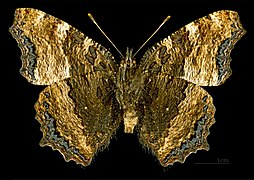Big fox
| Big fox | ||||||||||||
|---|---|---|---|---|---|---|---|---|---|---|---|---|

Big fox ( Aglais polychloros ) |
||||||||||||
| Systematics | ||||||||||||
|
||||||||||||
| Scientific name | ||||||||||||
| Nymphalis polychloros | ||||||||||||
| ( Linnaeus , 1758) |

The great fox ( Nymphalis polychloros ) is a butterfly (day butterfly ) from the noble butterfly family (Nymphalidae). It was named Butterfly of the Year 2018 by the BUND environmental foundation.
description
The moths reach a wingspan of 50 to 55 millimeters. They look very similar to the little fox ( Aglais urticae ), but are slightly larger and more dull in color. They have orange-colored wing tops with a black-yellow-white pattern. The edge of the hind wings is much weaker blue, but also has a dark border. The hind wings are almost evenly colored orange and each have a black spot.
The caterpillars are about 45 millimeters long. They are dark gray, almost black in color, and have orange bands on the back and sides. They also have orange-colored, ramified thorns.
Similar species
- Little fox ( Aglais urticae )
- Eastern big fox ( Aglais xanthomelas )
- Aglais vaualbum
Occurrence
The animals are found in North Africa , southern and central Europe , Turkey , southern Russia , the central and southern Urals , Kazakhstan and the Himalayas . In Central Europe they come from a. in the warmer regions, but have become rarer. The stocks fluctuate very strongly from year to year. In Germany, they are particularly widespread in the southwest (Baden-Württemberg and Rhineland-Palatinate) and in the east (Saxony). In the Mediterranean and the Southern Alps , they are still common. They live in sparse forests , on the edges of the forest, in parks and gardens, on dry grasses covered with bushes, as well as on orchards.
Way of life
The moths seldom suckle on blossoms, but prefer escaping tree sap. In spring, however, they often fly to blooming willows . You can also find them on forest paths in summer when sucking excrement and carrion. The moths fly in one generation in Central Europe from late June to May of the following year, in the south they fly in two generations. Hibernating moths appear as early as March. The species often flies to Central Europe from the south as a migratory butterfly .
Food of the caterpillars
The caterpillars eat leaves from various deciduous trees. They feed mainly on white willow ( Salix caprea ), but also on quivering aspen ( Populus tremula ), pears ( Pyrus communis ) and occasionally others. Cherries are also regionally the most important host plant. The use of pesticides in fruit crops had a very negative effect on the population of the species.
development
The females lay their eggs on the bark of thin branches of their caterpillar forage plants. The caterpillars live gregariously, but do not eat the branches completely bare before moving on to the next. They pupate in the ground vegetation and hatch in midsummer. Shortly afterwards, they retire to their winter hiding places very early.
Hazard and protection
The great fox is endangered by intensification measures in agriculture and forestry, as these significantly impair the habitats of the species. For example, orchards were destroyed by converting them into arable land or settlement areas, sallow pastures were knocked out, and biocides were increasingly used in fruit growing and horticulture. In order to protect the species, the gregarious caterpillars in particular should not be controlled.
Since the populations of the great fox have declined sharply in recent decades, it is now classified as endangered in Germany's Red List of Endangered Animals (3). In Austria , too , the species is rarely found; it is considered a sensitive bio-indicator . However, there have been contrary observations in recent years, a more frequent occurrence of the species, for example in Upper Bavaria. Similar observations (population increases) are also available for Rhineland-Palatinate.
swell
Individual evidence
- ↑ www.bund-nrw-naturschutzstiftung.de: Butterfly of the year 2018: "Großer Fuchs" (accessed November 12, 2017)
- ↑ a b c d e f Heiko Bellmann : The new Kosmos butterfly guide. Butterflies, caterpillars and forage plants. Franckh-Kosmos, Stuttgart 2003, ISBN 3-440-09330-1 , p. 176.
- ↑ a b Tom Tolman, Richard Lewington: Die Tagfalter Europäische und Nordwestafrikas , p. 144, Franckh-Kosmos Verlags-GmbH & Co, Stuttgart 1998, ISBN 3-440-07573-7
- ↑ a b c d e Wolfgang Düring: The Great Fox. In: Species portraits of butterflies in Rhineland-Palatinate. BUND RLP, December 12, 2019, accessed on February 24, 2020 (German).
- ↑ Günter Ebert (Ed.): The butterflies of Baden-Württemberg Volume 1, Tagfalter I (Ritterfalter (Papilionidae), Weißlinge (Pieridae), Edelfalter (Nymphalidae)), Ulmer Verlag Stuttgart 1993. ISBN 3-8001-3451-9
- ↑ Federal Agency for Nature Conservation (Ed.): Red List of Endangered Animals in Germany. Landwirtschaftsverlag, Münster 1998, ISBN 978-3-89624-110-8
- ↑ Gerfried Deschka, Josef Wimmer, The Butterfly Fauna of the Cross Wall, Contribution. Naturk. Upper Austria, 2000
- ^ Nymphalis polychloros
literature
- LG Higgins, ND Riley: The Butterflies of Europe and Northwest Africa. Paul Parey Publishing House, January 1978, ISBN 3-490-01918-0
- Manfred Koch : We determine butterflies. Volume 1: Butterfly. 4th enlarged edition. Neumann, Radebeul / Berlin 1966, DNB 457244224 .
- Hans-Josef Weidemann: Butterfly: observe, determine , Naturbuch-Verlag Augsburg 1995, ISBN 3-89440-115-X
Web links
- Lepiforum e. V. Taxonomy and Photos
- www.schmetterling-raupe.de
- Moths and Butterflies of Europe and North Africa (English)
- Aglais polychloros in Fauna Europaea
- Species portraits of butterflies in Rhineland-Palatinate - The Great Fox




